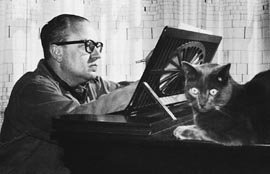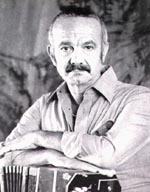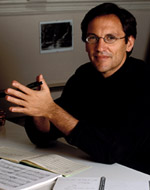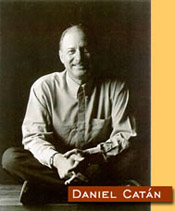
Latin American Composers on the World Stage
The most widely recognized Argentine composer of the twentieth century was Alberto Ginastera (1916-1983). His career parallels some of the trends just mentioned. For example, his works from the 1930s and 40s, such as the ballets Estancia and Panambí, are decidedly nationalist in orientation; of all his compositions, they are probably the most frequently played and recorded today.
By the 1950s, however, Ginastera was composing in the style of the European avant-garde, which meant turning toward greater abstraction and dissonance. When he used Argentine folk materials, he did so in such a subtle way that few listeners would detect their presence. This strategy emerges in Ginastera's Second String Quartet, which premiered in 1958 at one of the Inter-American Music Festivals sponsored by the Pan American Union of Washington D.C..
Composer: Alberto Ginastera
-
"String Quartet no. 2, Movement 1"
Composer: Alberto Ginastera
-
"String Quartet no. 2, Movement 1" [ 00:00-00:06 ]00:05
Exposition: Introductory statement (note pizzicato in viola and cello)
Composer: Alberto Ginastera
-
"String Quartet no. 2, Movement 1" [ 00:06-01:26 ]01:20
Repeated notes (first main section begins), many double stops throughout
Composer: Alberto Ginastera
-
"String Quartet no. 2, Movement 1" [ 01:25-01:45 ]00:19
Transition to new section
Composer: Alberto Ginastera
-
"String Quartet no. 2, Movement 1" [ 01:45-03:00 ]01:16
Second main section begins (calmer, change of texture)
Composer: Alberto Ginastera
-
"String Quartet no. 2, Movement 1" [ 03:01-04:46 ]01:45
Development: Starts off with repeated notes (like exposition) Lots of double stops, tension builds
Composer: Alberto Ginastera
-
"String Quartet no. 2, Movement 1" [ 04:45-05:20 ]00:34
Recapitulation: Return to first main section Restatement of second main section
Ginastera also benefitted from the Rockefeller Foundation, which promoted hemispheric good will through the arts. The Center for Advanced Musical Study (Instituto Torcuato di Tella, Buenos Aires) was sponsored by the Foundation and directed by Ginastera between 1963 and 1971. It became a magnet for composers from around the world who traveled there to absorb the latest compositional techniques. Ginastera also composed several operas. One of them, Bomarzo, was wildly applauded at its premiere in Washington, D.C. in 1967, but was banned in Buenos Aires because the dictatorship then in power found its explicitly sexual topics scandalous.
So many Latin American composers of concert music have since risen to prominence in the international musical scene that it is impossible to do justice to all of them here. One of the more famous is Astor Piazzolla (1921-1992), also from Argentina. He grew up listening to the tango, a dance with a decisive beat and, when sung, plaintive lyrics. Piazzolla combined some aspects of the traditional tango with jazz elements; he also composed in the concert genres of concerto and string quartet.
From another generation of Argentine composers is Osvaldo Golijov (b. 1960), who grew up listening to klezmer music, European concert music, and Piazzolla's innovative tangos. His music seems to know no stylistic boundaries: it combines klezmer, salsa, rumba, flamenco, and even Baroque elements, as in his retelling of the final days of Christ (St. Mark Passion - La pasión según San Marcos) against the backdrop of a Brazilian street festival. His first opera Ainadamar ("Fountain of Tears" in Arabic)-premiered in the Tanglewood Music Center in 2003-is about the assassination of the Spanish poet Federico García Lorca, which had earlier inspired the Mexican composer Silvestre Revueltas. Listen to the following excerpt of Arresto (Arrest) from Act 2 of Ainadamar.
Composer: 0
-
"Arresto"
Golijov's works are widely performed and have received Grammy nominations. In 2003, he was named a MacArthur Fellow and received a grant of $500,000, with no strings attached.
Another important composer is Mario Lavista, born in Mexico City in 1943. At age twenty, he began studying composition with Carlos Chávez and later worked with some of Europe's leading avant-garde composers. His music from the 1960s is decidedly experimental: one chamber work requires several woodwind instruments, five woodblocks, and three shortwave radios while another, Kronos, calls for fifteen alarm clocks.
Daniel Catán (1949-2011), born in Mexico City, has also become a truly international figure-Encantamiento: Music of Daniel Catán, was a 2018 Grammy Awards nominee in the Classical Compendium category. He studied philosophy and music in England, received a Ph.D. from Princeton University, returned to Mexico, and later, resided in South Pasadena, California until his untimely death in Austin (Texas), a few days after he attended rehearsals for his opera Il Postino at the Moores Opera Center at the University of Houston.
Catán wrote vocal, chamber, orchestral, and choral music as well as music for ballet, film, and TV, but is perhaps best known for his widely performed operas.
He was the first Mexican composer to have an opera produced in the United States, when San Diego Opera staged his first opera, Rappaccini's Daughter, in March 1994. In the following aria excerpt from that work, listen for Catán's signature neo-Romantic sounds: tonal harmonies, lush orchestration, and lyrical melodies, qualities that make his music extremely appealing for singers and audiences alike.
Composer: Daniel Catán
-
"Rappaccini's Daughter: Beatriz's final Aria"
Catán's second opera Florencia en el Amazonas, which alludes to the novel Love in the Time of Cholera by the Colombian writer Gabriel García Márquez, premiered in Houston in 1996-the first opera in Spanish to be commissioned by an opera company in the United States. In it, he combines late-Romantic operatic style with a modern musical language, highlighted with artful percussion effects and immensely gratifying vocal writing. Catán always used Spanish-language librettos. It was important to him to bridge the cultural divide he saw between Latin America and the United States. In an interview with the Los Angeles Times, he once posed the question, "At what point are we going to start thinking of these [operas] as enriching our culture, rather than being examples of some exotic other culture?"
Composer: 0
-
"Florencia en el Amazonas"
In his third opera, Salsipuedes, a Tale of Love, War and Anchovies (Las Bodas de Salsipuedes), also commissioned by the Houston Grand Opera and premiered on October, 2004, Catán includes Caribbean instruments and rhythms. His fourth and last opera, Il Postino was premiered by the Los Angeles Opera in 2010, with Plácido Domingo as the Chilean writer Pablo Neruda, a role written specifically for him. Catán died while working on his next opera, Meet John Doe, which had been commissioned by the Sarah and Ernest Butler School of Music at the University of Texas at Austin.
Of his own music Catán poignantly said: "I have inherited a very rich operatic tradition. In my work, I am proud to say, one can detect the enormous debt I owe to composers from Monteverdi to Alban Berg. But perhaps the greatest of my debts is having learnt that the originality of an opera need not involve the rejection of our tradition-which would be like blindly embracing the condition of an orphan-but rather the profound assimilation of it, so as to achieve the closest union between a text and its music."





String instruments did not exist in the Peru region prior to the Spanish conquest









